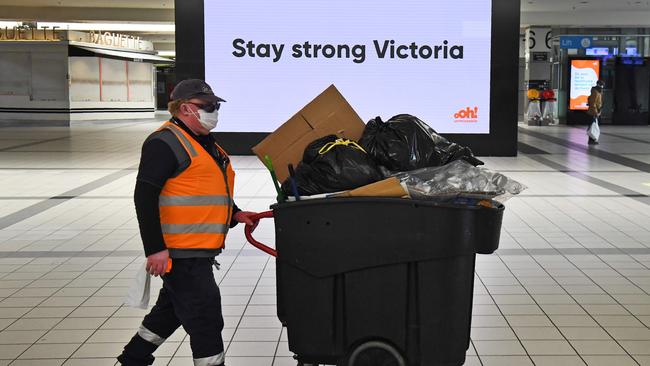
If Victoria’s harsh coronavirus lockdowns are being offset by a solid rebound in the national economy, will there be a need for as much macroeconomic stimulus as expected?
While on the surface the 111,000 rise in jobs was much better than expected, with job gains outside Victoria outweighing a 42,000 fall in that state — also much less than the 198,000 fall in Victoria’s first lockdown — economists were quick to point out that the jobs surge was driven by the self-employed with little rise in hours worked and potentially little rise in income.
The “effective” unemployment rate of 9.5 per cent — assuming an unchanged participation rate, to capture people who were discouraged from looking for work and left the labour force, as well as those working zero hours — was much higher than the official unemployment rate of 6.8 per cent, although well down on its April peak of 14.9 per cent, according to AMP Capital.
Part-time jobs rose by 74,800, but full-time jobs rose just 36,200, so while about 76 per cent of part-time jobs lost due to COVID-19 have been regained, only around 15 per cent of full-time jobs lost since the pandemic have been recovered, which means there’s some risk that initial temporary job losses are becoming more permanent, says AMP Capital senior economist Diana Mousina.
Moreover, there’s still plenty of spare capacity in the labour market, since hours worked were still down 5.1 year on year and the labour market under-utilisation rate — unemployed plus underemployed people — remained high at 18 per cent after peaking at 20.2 per cent in May.
“The Australian labour market recovery is progressing better than expected,” says Mousina.
“But there is still a long way to go to get the labour market back to its pre-COVID shape.”
AMP still expects further easing by the RBA at its next meeting in a “Team Australia” move, along with more fiscal stimulus from the federal government in the budget the same day.
“Further RBA easing is likely to involve a combination of cutting the cash rate and the three-year bond yield target to 0.1 per cent, tweaking forward guidance to not raise the cash rate until full employment is reached and inflation is sustainably within the 2-3 per cent target band, and possibly adopting a more traditional quantitative easing program,” it says.
While 53 per cent of jobs lost due to COVID-19 have apparently been regained and 69 per cent of those who left the labour market seem to have re-entered, it’s far from back to normal.
“Second-round impacts of COVID-19 — bankruptcies, business closures — are also still a risk and could hit employment growth,” Mousina cautions. “And while job losses in Victoria were lower than expected in August, the extension in the lockdown means higher risks of more jobs being lost.”
The stronger-than-expected August jobs data — albeit boosted by self-employed people on potentially quite low income — has heightened the focus on a speech by RBA deputy governor Guy Debelle at 10.30am next Tuesday on The Australian Economy and Monetary Policy.
“Debelle will likely cite the research published in the RBA’s September bulletin on the economic effects of unconventional monetary policy,” ANZ economists say.
“This research concluded that pushing bond yields lower through unconventional monetary policy can have as much of an impact on the economy as conventional rate cuts.”
They argued that this keeps the prospect of further RBA policy steps on the table, but they don’t expect Debelle to signal any such moves are imminent.
Still, UBS quantitative analyst and equity strategist Pieter Stoltz is taking no chances.
He neutralised his previously positive position on the Australian discretionary retail sector in his “20/20” model share portfolio, based on his view that the relatively strong employment data this week may mean there’s less macroeconomic stimulus from here.
“We still like cyclicals but good jobs news could be bad news (on stimulus) for retail,” he says.
“Although a lower than expected unemployment rate is a longer-term positive, the potential for less stimulus is a short-term negative that could weigh on retail more than other sectors.”
More broadly, he notes share prices have been supported by stimulus-driven economic outcomes.
Within discretionary retail, he prefers Harvey Norman over JB Hi-Fi since Harvey Norman is trading at a 30 per cent price-to-earnings multiple discount to JB Hi-Fi versus its long-term historical average of a 4 per cent discount.
But while he sees downside risk for equities after the September quarter from a potential $70bn “fiscal cliff” caused by plans to taper fiscal support programs like JobKeeper, Stoltz feels the economic signposts overall show no clear turning point in the positive momentum.
On that basis his model portfolio remains overweight on cyclical sectors including gaming, where he likes Tabcorp and Aristocrat.
Stoltz also neutralised a negative weighting in SkyCity Entertainment Group on account of its positive near-term earnings momentum.
In metals and mining, he prefers Independence over Western Areas, with looming positive catalysts for Independence, and BHP over Rio Tinto, which has operational and commodity price headwinds.
In steel, he still likes Sims Metal over BlueScope. He also removed sector preferences in gold, amid positive news for Evolution, and also in building materials as UBS upgraded Adbri to neutral.
In telcos, he removed a negative weight in TPG since the share price fell, but maintains a positive weight in Telstra based on its attractive free cashflow yield.
A negative weight on Brambles was driven by its low free cashflow yield.
In utilities, despite some headwinds in 2020-21, he still prefers APA for its growth opportunities.




Stronger-than-expected August employment data this week raised an intriguing possibility.